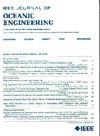浅水测深绘图的相位速度反演
IF 3.8
2区 工程技术
Q1 ENGINEERING, CIVIL
引用次数: 0
摘要
本研究探索了利用重力水波传播的俯视图影片来重建浅水水体的水下床面剖面。在尺寸为 0.48 × 1.80 × 0.40 m$^{3}$ 的波浪槽中,由微控制器驱动的平板挡板产生了 2.8 和 3.1 Hz 的水波。为了模仿海岸线附近的典型海床,使用了三种不同的海床剖面,即倾斜面、阶梯面和分裂面。录制了波浪传播的顶视视频,并通过视频分析将其转换为空间相位速度图像。相位速度图像可用于利用线性水波的频散关系重建水下床面剖面。我们还提出了一种解调方法,用于校正因波浪干扰引起的相位速度变化。该校正方法有助于改善深度剖面预测的平均百分比误差,斜面剖面的误差从 15%降至 10%,阶梯剖面的误差从 45%降至 15%。然而,由于波壁效应和复杂的干扰模式,该方法在剖分剖面上的效果较差。这项研究表明,所建议的方法可以利用时间演化或视频数据确定海岸线周围的深度水平,其准确度为 10%,干扰最小。本文章由计算机程序翻译,如有差异,请以英文原文为准。
Phase Speed Inversion for Shallow Water Bathymetry Mapping
This study explored the use of top-view movies of propagating gravity water waves to reconstruct the underwater bed profile of shallow water bodies. Water waves of 2.8 and 3.1 Hz were generated by a microcontroller-driven flat flap in a wave flume of dimensions 0.48 × 1.80 × 0.40 m
$^{3}$
求助全文
通过发布文献求助,成功后即可免费获取论文全文。
去求助
来源期刊

IEEE Journal of Oceanic Engineering
工程技术-工程:大洋
CiteScore
9.60
自引率
12.20%
发文量
86
审稿时长
12 months
期刊介绍:
The IEEE Journal of Oceanic Engineering (ISSN 0364-9059) is the online-only quarterly publication of the IEEE Oceanic Engineering Society (IEEE OES). The scope of the Journal is the field of interest of the IEEE OES, which encompasses all aspects of science, engineering, and technology that address research, development, and operations pertaining to all bodies of water. This includes the creation of new capabilities and technologies from concept design through prototypes, testing, and operational systems to sense, explore, understand, develop, use, and responsibly manage natural resources.
 求助内容:
求助内容: 应助结果提醒方式:
应助结果提醒方式:


